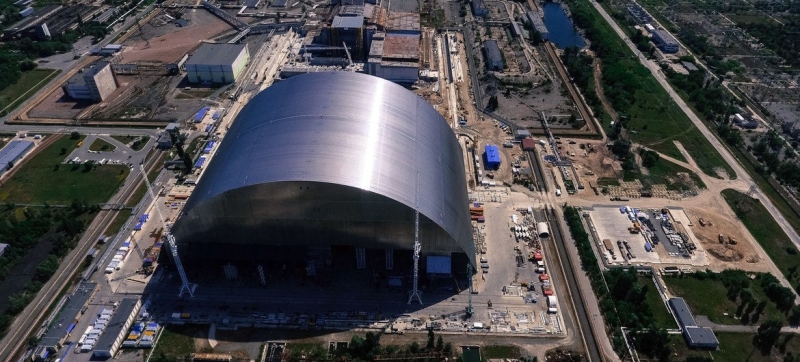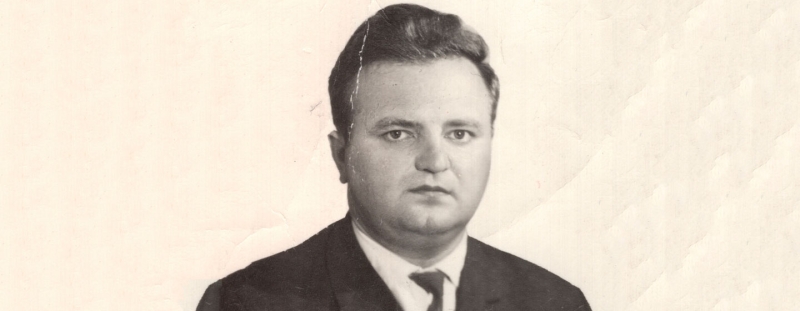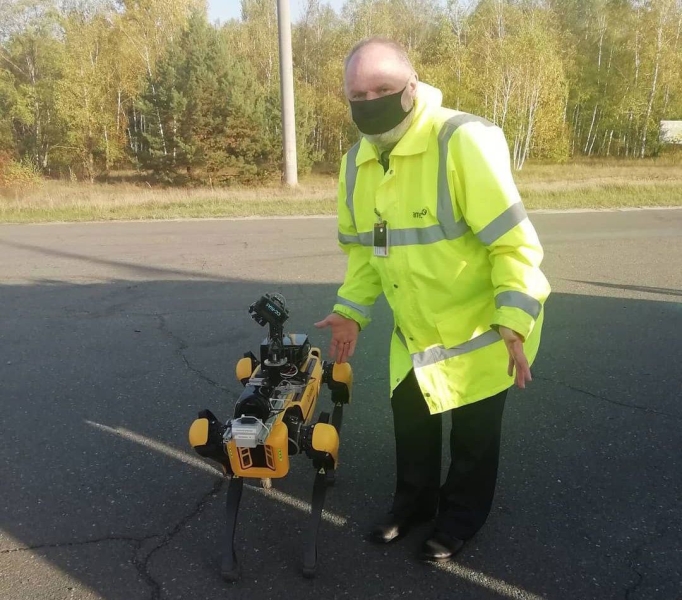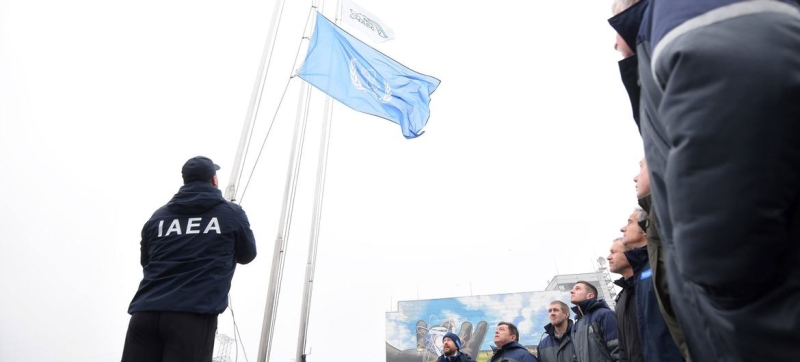
After the accident, a protective sarcophagus was built over the fourth reactor of the Chernobyl nuclear power plant. PLOT | “Chernobyl challenges us every minute” Peace and security
38 years ago, one of the world’s largest man-made disasters in human history occurred – the accident at the Chernobyl nuclear power plant. Then, in record time and through the heroic efforts of the personnel, it was possible to close the destroyed 4th power unit of the Chernobyl nuclear power plant with a concrete sarcophagus and stop the further spread of radiation. More than 200 thousand men and women took part in the liquidation of the Chernobyl disaster.
Many of those who today remember April 1986 do not like to talk about it – it is too painful to remember, because many friends and colleagues are no longer alive today: they died from the consequences of the disaster. About what happened on the day of the accident, about the situation two years after the occupation of the Chernobyl Nuclear Power Plant by Russian troops, and about how the safety of the plant is ensured today – in a report by the UN News Service.
Evacuation
“On the eve of April 26, my husband, Yuri Margevich, was on a business trip, which had to be interrupted – he was found right in the middle of the night and asked to urgently return. I was waiting for him in the morning, but he left without stopping home, in what he was wearing, without things, without anything, and returned to Kyiv only in mid-May. Yuri didn’t explain anything to me at that moment. A little later, my husband called and said that the reactor had exploded (what that meant was difficult to understand then), he was in Pripyat and people urgently needed to be taken out! The husband was a motorist and then organized transport for evacuation. Then he called and said that we needed to close the windows. But again, without details,” says the widow of the liquidator of the Chernobyl disaster, Nina Margevich.

Yuri Margevich
“By that time, rumors had already reached Kyiv and everyone knew that something had happened in Chernobyl. There were many buses going in that direction. The government hid everything. It was on the eve of May 1st, a May Day demonstration was organized in Kyiv, people came out with children. Everyone acted as if nothing had happened. Although at that moment the radioactive cloud went towards Kyiv and had already reached the city.”
Summer without children’s voices
Nina recalls: when news of the accident became known, people rushed to take the children out. “We rushed to the stations, there were no tickets, the children were left in the carriages themselves, and someone met them at their destination (there were no places on the trains for accompanying parents or relatives). I remember how Kyiv was empty, I remember that summer when there was deathly silence on the streets, it was unusual – a summer without children’s voices.”
“My husband talked about how Pripyat and the surrounding villages were evacuated, how people and cows were taken out in trucks. There was a headquarters in Ivankov where those who took part in eliminating the consequences of the disaster were located. My husband called from there every day before work and said things were bad. He talked about how the forest turned red, from green conifers to straight red. Nina recalls how sandbags were loaded onto helicopters to cover the exploded reactor. “All this had a bad effect on his health. Yes, everyone who worked in the immediate vicinity then was in hospitals with various consequences. Many people died – my husband’s friends, colleagues. More than 40 thousand motorists and road workers took part in eliminating the consequences of the Chernobyl accident. There was a problem with their radiation protection. Therefore, many of them died prematurely. Yuri himself has also not been with us for many years – he died of liver cancer. This is the cancer that “Chernobyl survivors” often suffered from,” says the widow of the liquidator. “It was all scary.” I talk about this and worry, as if I’m experiencing everything all over again, it’s hard to remember about it.”
Aleksandr Novikov, the accident liquidator and today the head of projects and programs at the Chernobyl Nuclear Power Plant engineering center, does not like to remember the events of 1986. Then, in 1986, he was only 20 years old. Alexander was a dosimetrist and arrived at the station on June 22.
“It was all very scary and bloody. I don’t like to remember 1986 because it hurts. I just want to say that we need to break stereotypes about Chernobyl. Official Soviet propaganda had to say that the fools at the Chernobyl nuclear power plant violated all sorts of instructions and blew up a very good RBMK reactor. This is not true!”
“The shortcomings of the RBMK were known to its creators before the accident”
This was confirmed in his report by the former chief engineer of the Chernobyl nuclear power plant, Nikolai Steinberg. He was appointed 10 days after the accident and served in this position for almost a year.
“The direct cause of the accident was the design features of the RBMK. Due to its design characteristics, the reactor was doomed and was only waiting for the implementation of the appropriate initial conditions. On April 26, 1986, these conditions were created. The authors of the report of the international group of experts on nuclear safety under the Director General of the IAEA came to similar conclusions,” Steinberg wrote. According to him, the shortcomings of the RBMK were known to its creators before the accident and this fact was documented; there were plans to modernize these reactor plants.
“The politicization of nuclear science and technology of the USSR, the image of their exclusivity and infallibility created over the years, the absence of an independent nuclear regulatory body are also the reasons for the Chernobyl tragedy. The catastrophe, which, due to its scale, affected the interests of many countries of the world, destroyed the myth of infallibility. The task was to present the causes of the accident in such a way that the true picture of the state of affairs would be revealed to the least extent and would not call into question the safety of Soviet nuclear energy as a whole. This is how the slogan “it’s the staff’s fault” came into being,” Nikolai Steinberg said in his report.
“The Chernobyl NPP personnel took the first and most powerful blow”
“The station staff took the first, most powerful blow – and these are not only those heroes who died in the first days and about whom everyone knows, these are thousands of people who went through Chernobyl, eliminated the consequences of the disaster, built a unique structure – the Shelter object “,” says Alexander Novikov. The construction of the “sarcophagus” was carried out around the clock.

Alexander Novikov
At night, the work site was illuminated by a spotlight that was mounted on a balloon. Within six months, the unique “Shelter” object was ready.
“When we get together with the guys and remember those who did not live, we always dedicate one of the toasts to the women – they washed the floors, worked in the canteen, in the first-aid post, changed our clothes, prepared food. But no one remembers them at all; they are forgotten and lost. But without them there would be no heroism. Because if you are not fed, not changed, if you have not been helped, then all this becomes impossible. Heroic professions are always mentioned, but simple ones are not,” says Alexander Novikov and immediately remembers. – I then worked in the occupational health and safety department. The standard dosimeters stopped working at that moment. We were very young boys then. And so Kaplun Tamara Azatovna taught us. Nothing worked because the doses were large and the film was exposed to light. We were waiting for the new system to arrive. And Tamara Azatovna looked after us as if she were her own children; it was an ocean of love, care and patience. She treated us like her own children. It was so touching that I remember now and it gives me goosebumps,” says Alexander and immediately turns the conversation to the problems of today.
“We work today as if we were back in 1986”
Two years ago, in the spring of 2022, at the beginning of the full-scale Russian invasion of Ukraine, the Chernobyl Nuclear Power Plant found itself under Russian occupation.
The nuclear power plant is separated from the city of Slavutich, where Chernobyl NPP employees mainly live, by 14 kilometers of neighboring Belarus. “We used to pass them by train, but now the bridges there have been destroyed. This became an insurmountable obstacle for the personnel, who previously traveled to the Chernobyl nuclear power plant in 40 minutes. Now the road to the station takes 6-8 hours, we travel through Kyiv. Employees work on shifts, and this is very difficult. We work as if we are back in 1986. Plus, even though we are a nuclear power plant, many of our people went to war. There are deaths both in the city and at the station. But finding new people who could be so quickly trained to work at nuclear power plants is very difficult. People, of course, adapt. But I believe that today the station fulfills its functions of maintaining the safety level is a real feat, as if the liquidation of 1986 continues,” says Alexander Novikov.
“Risks from attacks on critical infrastructure for nuclear power plants are significant”
Nuclear energy and security issues in war conditions are a particularly relevant topic for the Ukrainian energy sector now, and the main one at the International Conference on Decommissioning of Nuclear Facilities and Environmental Restoration, which is currently taking place in Slavutych. Representatives from different countries take part in the event. Alexander Novikov is one of the speakers from the Chernobyl Nuclear Power Plant.
Recently, the head of the International Atomic Energy Agency (IAEA), Rafael Mariano Grossi, stated at a briefing at the UN Security Council that two years of war had seriously affected the nuclear safety of the Zaporozhye nuclear power plant. This is Europe’s largest nuclear power plant, which is still occupied by Russian troops. According to Grossi, the world is very close to a nuclear disaster and the international community cannot allow chance to “decide what happens tomorrow.” “Despite the fact that six reactors of the Zaporozhye nuclear power plant are now in cold shutdown, and the last power unit was recently transferred to this status on the recommendation of the IAEA, the potential danger of a major nuclear accident remains very real,” he said.
Read also:
Head of the IAEA : the danger of a nuclear accident at Zaporizhia NPP is quite real
Alexander Novikov confirms that Ukrainian nuclear power plants are now in particular danger due to the war. “Even a shutdown Chernobyl station requires a certain consumption, including electricity. Any impacts to the infrastructure could lead to the station being de-energized. And this will be a significant risk,” says the Chernobyl NPP specialist. “We experienced this during the occupation, when one power line was damaged and the station was completely de-energized. But it is necessary to conduct radiation and technical control, and ensure cooling of nuclear fuel. A nuclear power plant is not a candy factory – it cannot be locked and production stopped. Not so here. The station continues to operate for many years. There are a lot of tasks that need to be performed on site. Therefore, the risks from attacks on critical infrastructure for nuclear power plants are significant.”

IAEA inspectors are constantly present at the Chernobyl nuclear power plant.
IAEA inspectors continuously help ensure safety at Ukrainian nuclear power plants
“The IAEA, which has established a permanent mission with us, helps ensure the safety of the station. Agency inspectors are constantly present on our site. They control the issue of ensuring safety, in particular, of nuclear installations that are located at the Chernobyl nuclear power plant site,” says Alexander Novikov.
IAEA representatives are constantly present at Ukrainian nuclear power plants: nuclear power plants enjoy special protection in accordance with international humanitarian law.
“Chernobyl challenges us every minute”
“I would also like to clarify that what happened at the Chernobyl Nuclear Power Plant in 1986 is often called an accident. But this is not an accident. An accident is when a pipe bursts. And this is a catastrophe, the largest man-made disaster in the history of mankind, which affected the entire globe. There were fallouts all over California back then. This is a disaster that completely changed the course of history. The entire economy of the country then worked to overcome its consequences. Plus, this slowed down the development of nuclear energy and led to economic and political collapse,” emphasizes the Chernobyl nuclear safety specialist.
“And I would like to remind everyone that Chernobyl challenges us every year, every minute. And we must overcome this. No matter what happens, Chernobyl always requires close attention,” summed up Alexander Novikov.
